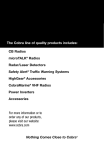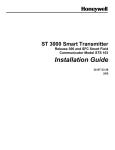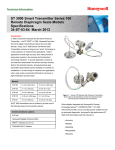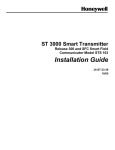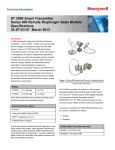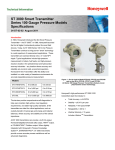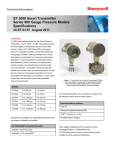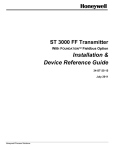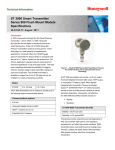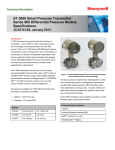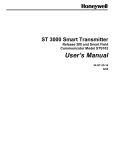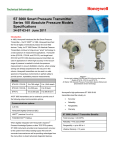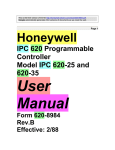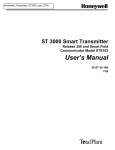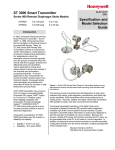Download Product Manual - Honeywell Process Solutions
Transcript
ST 3000 Smart Pressure Transmitter Quick Start Installation Guide 34-ST-25-24 Revision 9 July 2011 Honeywell Process Solutions Notices and Trademarks Copyright 2011 by Honeywell Revision 9 July 2011 SFC, Smartline, and ST 3000 are U.S. registered trademarks of Honeywell Inc. HART® is a trademark of the Hart Communication Foundation. FOUNDATION™ is a trademark of the Fieldbus Foundation. WARRANTY/REMEDY Honeywell warrants goods of its manufacture as being free of defective materials and faulty workmanship. Contact your local sales office for warranty information. If warranted goods are returned to Honeywell during the period of coverage, Honeywell will repair or replace without charge those items it finds defective. The foregoing is Buyer's sole remedy and is in lieu of all other warranties, expressed or implied, including those of merchantability and fitness for a particular purpose. Specifications may change without notice. The information we supply is believed to be accurate and reliable as of this printing. However, we assume no responsibility for its use. While we provide application assistance personally, through our literature and the Honeywell web site, it is up to the customer to determine the suitability of the product in the application. About This Document This document provides descriptions and procedures for the Quick Installation of your ST 3000 Transmitter. Various other documents are available for reference that describes how to Install, Configure, and Operate the ST 3000 Transmitter. These can be ordered on CD or hardcopy, or may be downloaded from http://honeywell.silverw.com . (Registration is required at this site) Document Title ii Document # ST 3000 Smart Transmitter and SFC Smart Field Communicator Model STS103 34-ST-25-14 ST 3000 FF Transmitter with Foundation Fieldbus Option Installation and Device Reference Guide 34-ST-25-15 ST 3000 Smart Transmitter Release 300 with HART Communications Option User Manual 34-ST-25-17 SMV 3000 Smart Multivariable Transmitter User’s Manual 34-SM-25-02 RMA Smart Meter User’s Manual 34-ST-25-08 Smart Field Communicator Model STS103 Operating Guide 34-ST-11-14 Smartline Confoguration Toolkit SCT 3000 Installation and Start-up Guide 34-ST-10-08 MC Toolkit User Manual 34-ST-25-20 ST 3000 Transmitter Quick Start Installation Guide July 2011 Rev.9 Contacts World Wide Web The following lists Honeywell’s World Wide Web sites that will be of interest to our customers. Honeywell Organization WWW Address (URL) Corporate http://www.honeywell.com/ps/hfs Honeywell Process Solutions http://hpsweb.honeywell.com/Cultures/en-US/ http://www.honeywell.com/ps International http://www.honeywell.com/business/global.asp Telephone Contact us by telephone at the numbers listed below. Organization Phone Number United States and Canada Honeywell Inc. 1-800-343-0228 Sales 1-800-525-7439 Service Asia Pacific Honeywell Asia Pacific Inc. (852) 8298298 Hong Kong Europe Honeywell PACE [32-2] 728-2111 Brussels Latin America Honeywell Inc (305) 364-2355 Sunrise, Florida USA Technical Assistance By Telephone Honeywell Solution Support Center Phone: 1-800-423-9883 (U.S. only) Outside the U.S. call: 1-602-313-6510 Additional Help You may also seek additional help by contacting the Honeywell distributor who supplied your ST 3000 transmitter. By E Mail You can also e-mail your technical questions or comments about this product to: Honeywell Solution Support Center e-mail: [email protected] Problem Resolution July 2011 Rev.9 If it is determined that a hardware problem exists, a replacement transmitter or part will be shipped with instructions for returning the defective unit. Please do not return your transmitter without authorization from Honeywell’s Solution Support Center or until the replacement has been received. ST 3000 Transmitter Quick Start Installation Guide iii Symbol Definitions The following table lists those symbols used in this document to denote certain conditions. Symbol Definition This CAUTION symbol on the equipment refers the user to the Product Manual for additional information. This symbol appears next to required information in the manual. WARNING PERSONAL INJURY: Risk of electrical shock. This symbol warns the user of a potential shock hazard where HAZARDOUS LIVE voltages greater than 30 Vrms, 42.4 Vpeak, or 60 VDC may be accessible. Failure to comply with these instructions could result in death or serious injury. ATTENTION, Electrostatic Discharge (ESD) hazards. Observe precautions for handling electrostatic sensitive devices Protective Earth (PE) terminal. Provided for connection of the protective earth (green or green/yellow) supply system conductor. Functional earth terminal. Used for non-safety purposes such as noise immunity improvement. NOTE: This connection shall be bonded to protective earth at the source of supply in accordance with national local electrical code requirements. Earth Ground. Functional earth connection. NOTE: This connection shall be bonded to Protective earth at the source of supply in accordance with national and local electrical code requirements. Chassis Ground. Identifies a connection to the chassis or frame of the equipment shall be bonded to Protective Earth at the source of supply in accordance with national and local electrical code requirements. iv ST 3000 Transmitter Quick Start Installation Guide July 2011 Rev.9 Contents 1 MOUNTING THE TRANSMITTER.........................................................................7 1.1 Typical Bracket mounted and Flange Mounted Installations .........................................................7 1.2 Bracket Mounting ...........................................................................................................................7 1.3 Flange Mounting...........................................................................................................................10 1.4 Flush Mounting.............................................................................................................................11 1.5 High Temperature Transmitter Mounting.....................................................................................11 1.6 Remote Seal Mounting .................................................................................................................12 1.7 Conduit Entry Plugs and Adapters................................................................................................13 2 TRIM THE TRANSMITTER .................................................................................15 2.1 3 Procedure to Trim the Transmitter................................................................................................15 SET THE JUMPERS............................................................................................16 3.1 Changing Default Failsafe Direction ............................................................................................16 3.2 Optional Write Protect Jumper .....................................................................................................17 CONNECT THE WIRING AND POWER UP........................................................ 18 4 4.1 Summary .......................................................................................................................................18 4.2 Wiring Connections ......................................................................................................................19 4.3 Lightning Protection .....................................................................................................................19 4.4 Additional Considerations for Wiring SMV 3000 Transmitter ....................................................20 5 CERTIFICATIONS...............................................................................................21 5.1 Product Certifications ...................................................................................................................21 5.1.1 Approved Manufacturing Locations ..................................................................................21 5.1.2 European Directive Information ........................................................................................21 5.2 Hazardous Location Certifications................................................................................................22 5.2.1 FM™ Approvals (USA).....................................................................................................22 5.2.2 Canadian Standards Association (CSA).............................................................................23 5.2.3 IECEx International Electrotechnical Commission (LCIE)...............................................24 5.2.4 SAEx (South Africa) ..........................................................................................................24 5.2.5 INMETRO (CERTU SP Brazil).........................................................................................25 5.2.6 ATEX Certification (LCIE) ...............................................................................................26 5.2.7 Pressure Equipment Directive (PED).................................................................................27 5.2.8 Other Certifications............................................................................................................27 July 2011 Rev.9 ST 3000 Transmitter Quick Start Installation Guide v vi ST 3000 Transmitter Quick Start Installation Guide July 2011 Rev.9 1 Mounting the Transmitter 1.1 Typical Bracket mounted and Flange Mounted Installations Angle Mounting Bracket Flat Mounting Bracket Horizontal Pipe Tank Wall Flange Connection Transmitter Flange Figure 1 1.2 Bracket Mounting Optional mounting bracket, see Figure 2 Existing mounting bracket, see Figure 3 Rotate the transmitter housing, see Figure 4 Level a transmitter with small absolute or differential pressure spans, see Figure 5. July 2011 Rev.9 ST 3000 Transmitter Quick Start Installation Guide 7 Optional Mounting Bracket Position bracket on 2-inch (50.8 mm) or, and install “U” bolt around pipe and through holes in bracket. Secure with nuts and lockwashers provided. Figure 2 Example - Angle mounting bracket secured to horizontal or vertical pipe. Nuts and Lockwashers Nuts and Lockwashers Mounting Bracket U-Bolt Mounting Bracket Horizontal Pipe Vertical Pipe U-Bolt Figure 2 Existing Mounting Bracket Align appropriate mounting holes in transmitter with holes in bracket and secure with bolts and washers provided. NOTE: If the meter body is hexagonal, you must use the additional bracket supplied. If meter body is round, discard the bracket Figure 3 Example – LGP model transmitter mounted to optional angle mounting bracket. If Transmitter is…. DP type with double-ended process heads and/or remote seals GP and AP with single-ended head In-line GP and AP (LGP model) Dual head GP Then…. Use alternate mounting holes in end of heads Use mounting holes in side of meter body Use smaller “U” bolt provided to attach meter body to bracket See Figure 3 Use mounting holes in end of process head LGP and LAP models Meter Body Smaller “U” bolt Use bracket for hexagonal meter body Figure 3 8 ST 3000 Transmitter Quick Start Installation Guide July 2011 Rev.9 Rotating Transmitter Housing Loosen set screw on outside neck of transmitter one full turn. Rotate Transmitter housing in maximum of 180 degree increment in left or right direction from center to position you require and tighten set screw (1.46 to 1.68 Nm/13 to 15 lb-in). Electronics Housing 180 degrees max. 180 degrees max. Set Screw Figure 4 Example – Rotating Transmitter Housing. Figure 4 Leveling Transmitters with Small Absolute or Differential Pressure Spans Mounting position of these transmitters is critical due to the smaller transmitter spans. To minimize these positional effects on calibration (zero shift), take the appropriate mounting precautions that follow for the given transmitter model. See Figure 5 and Figure 6 for suggestions on how to level the transmitter using a spirit balance. To perform a Zero Trim after leveling, refer to Section 0. Models STA122 and STA922 Center Section Process Head Position spirit balance on center section of meter body only. For a model STA122 or STA922 transmitter, you must ensure that the transmitter is vertical when mounting it. You do this by leveling the transmitter side-to-side and front-to-back. Figure 5 July 2011 Rev.9 ST 3000 Transmitter Quick Start Installation Guide 9 Mount transmitter vertically to assure best accuracy. Position spirit balance on pressure connection surface of AP body. Figure 6 1.3 Flange Mounting To mount a flange mounted transmitter model, bolt the transmitter’s flange to the flange pipe on the wall of the tank. On insulated tanks, remove enough insulation to accommodate the flange extension. It is the End User’s responsibility to provide a flange gasket and mounting hardware that are suitable for the transmitter’s service condition. To prevent degradation of performance in Flush-Mounted Flanged Transmitters, exercise care to ensure that the internal diameter of the flange gasket does not obstruct the sensing diaphragm. To prevent degradation of performance in Extended Mount Flanged Transmitters, ensure that there is sufficient clearance in front of the sensing diaphragm body. 10 Attention: Dotted area indicates use with closed tank with reference leg. Maximum Level Variable Head H1 Reference Leg Minimum Level HP Side mounted to tank LP Side vented to atmosphere Figure 7 ST 3000 Transmitter Quick Start Installation Guide July 2011 Rev.9 1.4 Flush Mounting To mount a flush mounted transmitter model, cut a hole for a 1-inch standard pipe in the tank or pipe where the transmitter is to be mounted. See Figure 8 Weld the 1-inch mounting sleeve to the wall of the tank or to the hole cut on the pipe. Insert the meter body of the transmitter into the mounting sleeve and secure with the locking bolt. Tighten the bolt to a torque of 6,4 Nm ±0,30 Nm [4.7 ft.-lbs. ±0.2 ft.-lbs.] 1” Pipe Mount 316 SS Weld Nipple (standard option) Once the transmitter is mounted, the transmitter housing can be rotated to the desired position. See Figure 4 On insulated tanks, remove enough insulation to accommodate the mounting sleeve. Figure 8 1.5 High Temperature Transmitter Mounting You can mount the high temperature transmitter directly to the process flange connection or the process piping. See Figure 9 Tank Wall To mount a flange mounted transmitter model, bolt the transmitter’s flange to the flange on the wall of the tank or process pipe. It is the End User’s responsibility to provide a flange gasket and mounting hardware that are suitable for the transmitter’s service condition. Once the transmitter is mounted, the transmitter housing can be rotated to the desired position. See Figure 4 Flange Connection Transmitter Flange On insulated tanks, remove enough insulation to accommodate the mounting sleeve. Process Pipe 1/2" NPT Connection Figure 9 July 2011 Rev.9 ST 3000 Transmitter Quick Start Installation Guide 11 1.6 Remote Seal Mounting Mount the transmitter at a remote distance determined by length of capiliary tubing. NOTE: The combination of tank vacuum and high pressure capillary head effect should not exceed 9 psi (300 mm Hg) absolute. On insulated tanks, remove enough insulation to accommodate the mounting sleeve. Figure 10 Example – Typical Remote Seal Transmitter installation. NOTE: For Sanitary 3-A installations, only mount the transmitter outside of the NonProduct Contact area where incidental contact with the process material is unlikely, use a minimum capillary length of 1.5m (5ft.) If Transmitter Model Number is…. STR93D or STR12D STR13D Then connect remote seal on…. high pressure (HP) side of transmitter to lower flange mounting on tank wall for variable head H1. low pressure (LP) side of transmitter to lower flange mounting on tank wall for variable head H1. STR93D or STR12D low pressure (LP) side of transmitter to upper flange mounting on tank wall for fixed or constant head H2. STR13D high pressure (HP) side of transmitter to upper flange mounting on tank wall for fixed or constant head H2. It is the End User’s responsibility to provide a flange gasket and mounting hardware that are suitable for the transmitter’s service condition LP Side - Model STR93D - Model STR12D HP Side - Model STR13D Maximum Level H2 Fixed Ref. Leg Variable Head H1 Minimum Level HP Side - Model STR93D - Model STR12D LP Side - Model STR13D Figure 10 12 ST 3000 Transmitter Quick Start Installation Guide July 2011 Rev.9 1.7 Conduit Entry Plugs and Adapters Honeywell Part No. Description Material 30679588-501 1/2 NPT Conduit Entry Plug Zinc Plated Carbon Steel 30749366-501 M20 Male to 1/2 NPT Female Certified Conduit Adapter 316 Stainless Steel (Silicone O-Ring) 50000547-501 M20 Certified Conduit Plug 316 Stainless Steel (Silicone O-Ring) 50000682-501 1/2 NPT Male to 3/4 NPT Female Certified Conduit Adapter 50021832-502 1/2 NPT Certified Conduit Plug 50021832-501 1/2 NPT Certified Conduit Plug 51202409-501 1/2 NPT Male to M20 Female Certified Conduit Adapter 316 Stainless Steel Zinc Plated Carbon Steel 316 Stainless Steel 316 Stainless Steel Environmental Rating Type 4X, IP 66-68* Type 4X, IP 66-68 Type 4X, IP 66-68 Type 4X, IP 66-68 Type 4X, IP 66-68 Type 4X, IP 66-68 Type 4X, IP 66-68 Ambient Limits Hazardous Location Certification –40°C to +93°C* –40°F to +199°F* None –50°C to +150°C –58°F to +302°F CSA Cl I, Div 1, Gp ABCD ATEX Ex II 2 GD; Ex d IIC IECEx Ex d IIC –50°C to +150°C –58°F to +302°F CSA Cl I, Div 1, Gp ABCD ATEX Ex II 2 GD; Ex d IIC IECEx Ex d IIC –50°C to +150°C –58°F to +302°F CSA Cl I, Div 1, Gp ABCD ATEX Ex II 2 GD; Ex d IIC IECEx Ex d IIC –50°C to +150°C –58°F to +302°F CSA Cl I, Div 1, Gp ABCD ATEX Ex II 2 GD; Ex d IIC IECEx Ex d IIC –50°C to +150°C –58°F to +302°F CSA Cl I, Div 1, Gp ABCD ATEX Ex II 2 GD; Ex d IIC IECEx Ex d IIC –50°C to +150°C –58°F to +302°F CSA Cl I, Div 1, Gp ABCD ATEX Ex II 2 GD; Ex d IIC IECEx Ex d IIC * Honeywell Specified Procedures It is the User/Installer’s responsibility to install the ST 3000 Wireless Transmitters in accordance with national and local code requirements. Conduit entry plugs and adapters shall be suitable for the environment, shall be certified for the hazardous location when required and acceptable to the authority having jurisdiction for the plant. Use the following procedures for installation. Conduit Entry Plugs see Table 1 & Figure 11 Conduit Adapters see Table 2 & Figure 11 July 2011 Rev.9 ST 3000 Transmitter Quick Start Installation Guide 13 Table 1 – Conduit entry plug installation Step 1 2 3 4 Action Remove the protective plastic cap from the threaded conduit entry(s). To ensure the environmental ingress protection rating on tapered (NPT), a non-hardening thread sealant may be used. Thread the appropriate size conduit plug (M20 or ½” NPT) into the conduit entry opening. Do not install conduit entry plugs in conduit entry openings if adapters or reducers will be used. Tighten plugs according to the following table. Description Tool Torque M20 Conduit Entry 10mm Hex Wrench 32 Nm 24 Lb-ft ½” NPT Conduit Entry 10mm Hex Wrench 32 Nm 24 Lb-ft Table 2 – Conduit adapter installation Step 1 2 3 4 Action Remove the protective plastic cap from the threaded conduit entry. To ensure the environmental ingress rating on tapered threads (NPT), a nonhardening thread sealant may be used. Thread the appropriate size adapter (M20 or ½ NPT) into the conduit entry opening Tighten adapters according to the following table. Description Tool Torque M20 to ½ NPT Adapter 15/16” or 24mm Wrench 32 Nm 24 Lb-ft ½ to ¾ NPT Adapter 1 ¼” Wrench 32 Nm 24 Lb-ft Figure 11 Electronic Housing Conduit Entries Note. No plugs come installed in the ST 3000 housings. All housings come with temporary plastic dust protectors (red) installed and are not certified for use in any installation. 14 ST 3000 Transmitter Quick Start Installation Guide July 2011 Rev.9 2 Trim the Transmitter 2.1 Procedure to Trim the Transmitter For a transmitter with a small differential pressure span, you must ensure that the transmitter is vertical when mounting it. You do this by leveling the transmitter side-to-side and front-to-back. See Figure 5 for suggestions on how to level the transmitter using a spirit balance. You must also zero the transmitter by following the steps in this table. Step 1 2 3 4 5 6 7 July 2011 Rev.9 Action Attach the transmitter to the mounting bracket but do not completely tighten the mounting bolts Connect a tube between the input connections in the high pressure (HP) and low pressure (LP) heads to eliminate the affects of any surrounding air currents. Connect 24 Vdc power to the transmitter and connect a digital voltmeter or SFC to read the transmitter’s output or connect a voltmeter across the 250 ohm resistor, if desired. Use applicable communicator to establish communications with the transmitter. For DE transmitter use SFC, SCT, or MCT. For Hart, use MCT or other Hart Communicator with applicable Honeywell DD's. For Fieldbus, use NI FBUS tools with applicable Honeywell DD's. While reading the transmitter’s output on a communication tool or a voltmeter, position the transmitter so the output reading is at or near zero, then completely tighten the mounting bolts. Do an input zero correct function using the communication tool. This corrects the transmitter for any minor error that may occur after the mounting bolts are tightened. Remove the tube from between the input connections, the power, and the digital voltmeter or communication tool. ST 3000 Transmitter Quick Start Installation Guide 15 3 Set the Jumpers 3.1 Changing Default Failsafe Direction Transmitters are shipped with a default failsafe direction of upscale. This means that the transmitter’s output will be driven upscale (maximum output) when the transmitter detects a critical status. You can change the direction from upscale to downscale (minimum output) by cutting jumper W1 on the printed wiring assembly. If your transmitter is operating in the analog mode, an upscale failsafe action will drive the transmitter’s output to greater than 21 mA or a downscale action will drive its output to less than 3.8 mA. If your transmitter is operating in the DE mode an upscale failsafe action will cause the transmitter to generate a “+ infinity” digital signal, or a downscale failsafe action will cause it to generate a “– infinity” digital signal. The STIMV IOP module interprets either signal as “not a number” and initiates its own configured failsafe action for the control system. The STDC initiates the failsafe mode configured through the transmitter when either signal is generated. NOTE: The failsafe direction display that you can access through the SFC only shows the state of the failsafe jumper in the transmitter as it correlates to analog transmitter operation. The failsafe action of the digital control system may be configured to operate differently than indicated by the state of the jumper in the transmitter. 16 Step 1 ATTENTION: Electrostatic Discharge (ESD) hazards. Observe precautions for handling electrostatic sensitive devices Action With transmitter on bench and no power applied. Loosen end-cap lock and unscrew end cap from electronics side of transmitter housing. 2 If applicable, unsnap Local Smart Meter from PWA mounting bracket and unplug cable from connector on back of meter assembly. Loosen two retaining screws and carefully pull mounting bracket and PWA from housing. Using retaining clip remove flex-tape connector from PWA Remove 2-wire power connector from PWA, and then remove PWA and mounting bracket assembly. 3 With component side of PWA facing you, locate failsafe jumper W1 and cut it in half with small wire cutter such as dykes. See Figure 10. This changes failsafe action from upscale to downscale. 4 Reverse applicable previous steps to replace PWA. 5 Turn ON transmitter power. Power Connector Meter Connector Failsafe Direction Jumper Figure 12 ST 3000 Transmitter Quick Start Installation Guide July 2011 Rev.9 3.2 Optional Write Protect Jumper The ST 3000 Pressure Transmitter (DE or HART) is now being shipped with a newly designed printed wiring assembly (PWA) that allows user access to the optional write protect jumper without removing the PWA. This version of the PWA is functionally identical to the previous version, with the same performance and specifications. The new version PWA differs only in location of the optional write protect jumper and the associated bracket and hardware. Do not remove the PWA as described in Section 3.1 Changing Default Failsafe Direction. Instead, follow the following steps. ATTENTION: Electrostatic Discharge (ESD) hazards. Observe precautions for handling electrostatic sensitive devices. WARNING! PERSONAL INJURY: Risk of electrical shock. Disconnect power before proceeding. HAZARDOUS LIVE voltages greater than 30 Vrms, 42.4 Vpeak, or 60 VDC may be accessible. Failure to comply with these instructions could result in death or serious injury Step 1 2 3 4 5 Action Place transmitter on bench. Remove power. Loosen end-cap lock and unscrew end-cap from electronics side of transmitter housing If applicable, unsnap local smart meter from PWA mounting bracket. Find the write protect jumper shown in Figure 11 below. Position the jumper for read-only or read/write. Reverse applicable previous steps to install smart meter and endcap. Re-connect transmitter power. Figure 13 July 2011 Rev.9 ST 3000 Transmitter Quick Start Installation Guide 17 4 Connect the Wiring and Power Up 4.1 Summary The transmitter is designed to operate in a two-wire power/current loop with loop resistance and power supply voltage within the operating range shown in Figure 14. Loop wiring is connected to the transmitter by simply attaching the positive (+) and negative (–) loop wires to the positive (+) and negative (–) SIGNAL screw terminals on the terminal block in the transmitter’s electronics housing shown in the table in Section 4.2. Each transmitter includes an internal ground terminal to connect the transmitter to earth ground. A ground terminal can be optionally added to the outside of the electronics housing. While it is not necessary to ground the transmitter for proper operation, we suggest that you do so to minimize the possible effects of “noise” on the output signal and provide additional protection against lightning and static discharge damage. 18 1440 1200 Loop Resistance (ohms) = Operating Area NOTE: A minimum of 250 0hms of loop resistance is necessary to support communications. Loop resistance equals barrier resistance plus wire resistance plus receiver resistance. 800 650 450 250 0 10.8 16.28 20.63 25 28.3 37.0 Operating Voltage (Vdc) 42.4 21012 Figure 14 ST 3000 Transmitter Quick Start Installation Guide July 2011 Rev.9 4.2 Wiring Connections This procedure shows the steps for connecting power to the transmitter. Step 1 For loop wiring and external wiring diagrams, refer to the installation drawings presented in the Transmitter Manual. 2 Action Loosen end-cap lock using a 1.5 mm allen wrench and remove end-cap cover from terminal block end of transmitter housing. Feed loop power leads through one of conduit entrances on either side of transmitter housing. Plug whichever entrance you do not use. ATTENTION Detailed drawings are provided for transmitter installation in nonintrinsically safe areas and for intrinsically safe loops in hazardous area locations. The transmitter accepts up to 16 AWG wire. 3 Observing polarity, connect positive loop power lead to SIGNAL + terminal and negative loop power lead to SIGNAL – terminal. 4 + - + - L -+ - + - + - TEST SIGNAL Loop Power METER + TEST If you will be using the transmitter in a hazardous area, be sure to review the hazardous location reference data included in Appendix B of the transmitter manual before operating the transmitter. + - - SIGNAL + Loop Power SIGNAL EXAMPLE - CONNECTING LOOP POWER TO TRANSMITTER. 3-screw terminal block 5-screw terminal block (option LP) ATTENTION All wiring must comply with local codes, regulations, and ordinances. Replace end-cap, and tighten end-cap lock. 4.3 Lightning Protection When your transmitter is equipped with optional lightning protection, you must connect a wire from the transmitter to ground as shown in Figure 15 to make the protection effective. We recommend that you use a size 8 (American Wire Gage) or (8.37mm2) bare or green covered wire. Electronics Housing Connect to Earth Ground Figure 15 July 2011 Rev.9 ST 3000 Transmitter Quick Start Installation Guide 19 4.4 Additional Considerations for Wiring SMV 3000 Transmitter Figure 16 SMV 3000 Transmitter Terminal Block Connect RTD leads to the TC terminals 1, 2, 3, and 4 as appropriate for the given probe type. Figure 17 RTD Input Wiring Connections. Connect thermocouple leads to terminals 1 (–) and 3 (+), observing polarity. Figure 18 Thermocouple Input Wiring Connections. 20 ST 3000 Transmitter Quick Start Installation Guide July 2011 Rev.9 5 Certifications 5.1 Product Certifications 5.1.1 Approved Manufacturing Locations Honeywell Process Solutions 512 Virginia Drive Fort Washington, PA 19034 Honeywell (Tianjin) Limited 66 BaiHe Road, Tianjin EconomicTechnological Development Area Tianjin, 300457, P.R. China Honeywell Automation India Limited 56 & 57 Hadapsar Industrial Estate Pune 411 013, India 5.1.2 European Directive Information The EC Declarations of Conformity for all applicable directives for this product can be found on the Honeywell website at www.honeywell.com/imc. A hard copy may be obtained by contacting your local Honeywell sales office. European Pressure Equipment Directive (PED) 97/23/EC The ST 3000 pressure transmitters are in conformity with the essential requirements of the PED. A formal statement from TÜV Industry Service Group of TÜV America, Inc., a division of TÜV Süddeutschland, a Notified Body regarding the Pressure Equipment Directive, is available upon request. Electromagnetic Compatibility (EMC) 89/336/EEC All ST 3000 Pressure Transmitters EN 50081-1: 1992; EN 50082-2: 1995; EN 61326: 1997 / A1: 1998 – Industrial July 2011 Rev.9 ST 3000 Transmitter Quick Start Installation Guide 21 5.2 Hazardous Location Certifications 5.2.1 FM™ Approvals (USA) Type of Protection Comm. Option Field Parameters All All T5 Ta = 93ºC 4-20 mA / DE Vmax = 42.4V Imax = 225mA Ci = 4.2nF Li = * Pi =1.2W T4 Ta = 93ºC 4-20 mA / Vmax = 30V Imax = 225mA Ci = 4.2nF Li = * Pi =1.2W T4 Ta = 93ºC Fieldbus – Entity (Not FISCO) Vmax = 32V Imax = 120mA Ci = 4.2nF Li = 0 Pi =0.84W T4 Ta = 40ºC T3 Ta = 93ºC Fieldbus – Entity (Not FISCO) Vmax = 24V Imax = 250mA Ci = 4.2nF Li = 0 Pi =1.2W T4 Ta = 40ºC T3 Ta = 93ºC FISCO Vmax = 17.5V Imax = 380mA Ci = 4.2nF Li = 0 Pi =5.32W T4 Ta = 40ºC T3 Ta = 93ºC 4-20 mA / DE Vmax = 42.4V Imax = 225mA Ci = 4.2nF Li = * Pi =1.2W T4 Ta = 93ºC 4-20 mA / HART Vmax = 30V Imax = 225mA Ci = 4.2nF Li = * Pi =1.2W T4 Ta = 93ºC Fieldbus – Entity (Not FNICO) Vmax = 32V Imax = 120mA Ci = 4.2nF Li = 0 Pi =0.84W T4 Ta = 40ºC T3 Ta = 93ºC Fieldbus – Entity (Not FNICO) Vmax = 24V Imax = 250mA Ci = 4.2nF Li = 0 Pi =1.2W T4 Ta = 40ºC T3 Ta = 93ºC Vmax = 32V Ci = 4.2nF Li = 0 T4 Ta = 40ºC T3 Ta = 93ºC Explosionproof: Class I, Division 1, Groups A, B, C, D locations Dust Ignition Proof: Class II, III, Division 1, Groups E, F, G locations, Enclosure Type 4X Intrinsically Safe: Class I, II, III, Division 1, Groups A, B, C, D, E, F, G locations, Enclosure Type 4X Intrinsically Safe: Class I, II, III, Division 1, Groups A, B, C, D, E, F, G locations; FM SM Approvals Class 1, Zone 0, AEx ia Group IIC, Enclosure Type 4X / IP 66/67 Nonincendive: Class I, Division 2, Groups A, B, C, D locations, Enclosure Type 4X Nonincendive: Class I, Division 2, Groups A, B, C, D; Suitable for: Class II, Division 2, Groups F&G; Class III, Division 2; Class I, Zone 2, Group IIC, Enclosure Type 4X / IP 66/67 FNICO Temp. Codes Li = 0 except Li = 150µH when Option ME, Analog Meter, is selected. FM ApprovalsSM is a service mark of FM Global 22 ST 3000 Transmitter Quick Start Installation Guide July 2011 Rev.9 5.2.2 Canadian Standards Association (CSA) Type of Protection Explosion Proof: Class I, Division 1, Groups B, C, D locations Dust Ignition Proof: Class II, III, Division 1, Groups E, F, G locations, Enclosure Type 4X Comm. Option All Canadian Standards Association (CSA) Canadian Registration Number (CRN): July 2011 Rev.9 T4 Ta = 93ºC 4-20 mA / DE T4 Ta = 93ºC 4-20 mA / HART Vmax = 42V Imax = 225mA Ci = 4.2nF Li = * Pi =1.2W T4 Ta = 93ºC Fieldbus – Entity (Not FISCO) Vmax = 24V Imax = 250mA Ci = 4.2nF Li = 0 Pi =1.2W T4 Ta = 40ºC T3 Ta = 93ºC 4-20 mA / DE Vmax = 42.4V Imax = 225mA Ci = 4.2nF Li = * Pi =1.2W T4 Ta = 93ºC 4-20 mA / HART Vmax = 30V Imax = 225mA Ci = 4.2nF Li = * Pi =1.2W T4 Ta = 93ºC Fieldbus – Entity (Not FNICO) Vmax = 24V Imax = 250mA Ci = 4.2nF Li = 0 Pi =1.2W T4 Ta = 40ºC T3 Ta = 93ºC Nonincendive: Class I, Division 2, Groups A, B, C, D locations, Enclosure Type 4X All Temp. Codes Vmax = 42V Imax = 225mA Ci = 4.2nF Li = * Pi =1.2W Intrinsically Safe: Class I, II, III, Division 1, Groups A, B, C, D, E, F, G locations, Enclosure Type 4X Field Parameters All ST 3000 models except STG19L, STG99L, STG170, STG180, STA17L and STA97L have been registered in all provinces and territories in Canada and are marked CRN: 0F8914.5C. ST 3000 Transmitter Quick Start Installation Guide 23 5.2.3 IECEx International Electrotechnical Commission (LCIE) Type of Protection Comm. Option Flameproof, Zone 1: Ex d IIC, Enclosure IP 66/67 IECEx International Electrotechnical Commission (LCIE) All All Temp. Codes T5 Ta = –50 to 93ºC T6 Ta = –50 to 78ºC 4-20 mA / DE Ui = 30V Ii = 100mA Ci = 4.2nF Li = * Pi =1.2W T4 Ta = –50 to 93ºC T5 Ta = –50 to 85ºC T6 Ta = –50 to 70ºC 4-20 mA / HART Ui = 30V Ii = 100mA Ci = 4.2nF Li = * Pi =1.2W T4 Ta = –50 to 93ºC T5 Ta = –50 to 63ºC T6 Ta = –50 to 48ºC Fieldbus (Not FISCO) Ui = 24V Ii = 250mA Ci = 4.2nF Li = 0 Pi =1.2W T3 Ta = –50 to 93ºC T4 Ta = –50 to 40ºC Intrinsically Safe, Zone 0/1: Ex ia IIC, Enclosure IP 66/67 Field Parameters Li = 0 except Li = 150µH when Option ME, Analog Meter, is selected. 5.2.4 SAEx (South Africa) Type of Protection Flameproof, Zone 1: Ex d IIC, Enclosure IP 66/67 Intrinsically Safe, Zone 0/1: Ex ia IIC, Enclosure IP 66/67 Comm. Option Field Parameters All All 4-20 mA / DE T4 Ta = –50 to 93ºC T5 Ta = –50 to 85ºC T6 Ta = –50 to 70ºC 4-20 mA / HART Ui = 30V Ii = 100mA Ci = 4.2nF Li = * Pi =1.2W T4 Ta = –50 to 93ºC T5 Ta = –50 to 63ºC T6 Ta = –50 to 48ºC Fieldbus (Not FISCO) Ui = 24V Ii = 250mA Ci = 4.2nF Li = 0 Pi =1.2W T3 Ta = –50 to 93ºC T4 Ta = –50 to 40ºC 4-20 mA / DE Ui = 30V Ii = 100mA Ci = 4.2nF Li = * Pi =1.2W T4 Ta = –50 to 93ºC T5 Ta = –50 to 85ºC T6 Ta = –50 to 70ºC 4-20 mA / HART Ui = 30V Ii = 100mA Ci = 4.2nF Li = * Pi =1.2W T4 Ta = –50 to 93ºC T5 Ta = –50 to 63ºC T6 Ta = –50 to 48ºC Fieldbus (Not FISCO) Ui = 24V Ii = 250mA Ci = 4.2nF Li = 0 Pi =1.2W T3 Ta = –50 to 93ºC T4 Ta = –50 to 40ºC Multiple Marking: Flameproof, Zone 1: Ex d IIC, Enclosure IP 66/67 Intrinsically Safe, Zone 0/1: Ex ia IIC, Enclosure IP 66/67 NOTE. The user must determine the type of protection required for installation of the equipment. The user shall then check the box [√] adjacent to the type of protection used on the equipment certification nameplate. Once a type of protection has been checked on the nameplate, subsequently the equipment shall not be reinstalled using any of the other certification types. 24 T5 Ta = –50 to 93ºC T6 Ta = –50 to 78ºC Ui = 30V Ii = 100mA Ci = 4.2nF Li = * Pi =1.2W SAEx (South Africa) Temp. Codes ST 3000 Transmitter Quick Start Installation Guide July 2011 Rev.9 5.2.5 INMETRO (CERTU SP Brazil) Type of Protection Comm. Option Field Parameters Temp. Codes All All T5 Ta = –50 to 93ºC T6 Ta = –50 to 78ºC Flameproof, Zone 1: BR-Ex d IIC Enclosure IP 66/67 INMETRO (CERTUSP) Brazil 4-20 mA / DE Ui = 30V Ii = 100mA Ci = 4.2nF Li = * Pi =1.2W T4 Ta = –50 to 93ºC T5 Ta = –50 to 85ºC T6 Ta = –50 to 70ºC 4-20 mA / HART Ui = 30V Ii = 100mA Ci = 4.2nF Li = * Pi =1.2W T4 Ta = –50 to 93ºC T5 Ta = –50 to 63ºC T6 Ta = –50 to 48ºC Fieldbus (Not FISCO) Ui = 24V Ii = 250mA Ci = 4.2nF Li = 0 Pi =1.2W T3 Ta = –50 to 93ºC T4 Ta = –50 to 40ºC Intrinsically Safe, Zone 0/1: BR-Ex ia IIC Enclosure IP 66/67 * Li = 0 except Li = 150µH when Option ME, Analog Meter, is selected. July 2011 Rev.9 ST 3000 Transmitter Quick Start Installation Guide 25 5.2.6 ATEX Certification (LCIE) Type of Protection Comm. Option Field Parameters Flameproof, Zone 0: , Ex tD Enclosure IP 66/67 All All A20 IP6X T95ºC Ta = 93ºC or T80ºC Ta = 78ºC All T5 Ta = –50 to +93ºC T6 Ta = –50 to +78ºC, A21 IP6X T95ºC Ta = 93ºC or T80ºC Ta = 78ºC Flameproof, Zone 1: , Ex d IIC, Ex tD Enclosure IP 66/67 All 4-20 mA / DE Ui = 30V Ii = 100mA Ci = 4.2nF Li = * Pi =1.2W T4 Ta = –50 to 93ºC T5 Ta = –50 to 85ºC T6 Ta = –50 to 70ºC 4-20 mA / HART Ui = 30V Ii = 100mA Ci = 4.2nF Li = * Pi =1.2W T4 Ta = –50 to 93ºC T5 Ta = –50 to 63ºC T6 Ta = –50 to 48ºC Fieldbus (Not FISCO) Ui = 24V Ii = 250mA Ci = 4.2nF Li = 0 Pi =1.2W T3 Ta = –50 to 93ºC T4 Ta = –50 to 40ºC 4-20 mA / DE Ui = 30V Ii = 100mA Ci = 4.2nF Li = * Pi =1.2W T4 Ta = –50 to 93ºC T5 Ta = –50 to 85ºC T6 Ta = –50 to 70ºC 4-20 mA / HART Ui = 30V Ii = 100mA Ci = 4.2nF Li = * Pi =1.2W T4 Ta = –50 to 93ºC T5 Ta = –50 to 63ºC T6 Ta = –50 to 48ºC Fieldbus (Not FNICO) Ui = 24V Ii = 250mA Ci = 4.2nF Li = 0 Pi =1.2W T3 Ta = –50 to 93ºC T4 Ta = –50 to 40ºC 4-20 mA / DE Ui = 30V Ii = 100mA Ci = 4.2nF Li = * Pi =1.2W T4 Ta = –50 to 93ºC T5 Ta = –50 to 85ºC T6 Ta = –50 to 70ºC 4-20 mA / HART Ui = 30V Ii = 100mA Ci = 4.2nF Li = * Pi =1.2W T4 Ta = –50 to 93ºC T5 Ta = –50 to 63ºC T6 Ta = –50 to 48ºC Fieldbus (Not FISCO/FNICO) Ui = 24V Ii = 250mA Ci = 4.2nF Li = 0 Pi =1.2W T3 Ta = –50 to 93ºC T4 Ta = –50 to 40ºC Intrinsically Safe, Zone 0/1: , Ex ia IIC, Enclosure IP 66/67 ATEX (LCIE) Non-Sparking, Zone 2: ,Ex nA IIC (Honeywell), Enclosure IP 66/67 Multiple Marking: Flameproof, Zone 1: , Ex d IIC Intrinsically Safe, Zone 0/1: , Ex ia IIC Temp. Codes Non-Sparking, Zone 2: , Ex nA IIC NOTE: The user must determine the type of protection required for installation of the equipment. The user shall then check the box [ √ ] adjacent to the type of protection used on the equipment certification nameplate. Once a type of protection has been checked on the nameplate, subsequently the equipment shall not be reinstalled using any of the other certification types. * Li = 0 except Li = 150µH when Option ME, Analog Meter, is selected. 26 ST 3000 Transmitter Quick Start Installation Guide July 2011 Rev.9 5.2.7 Pressure Equipment Directive (PED) The ST 3000 Smart Pressure Transmitters are in conformity with the essential requirements of the Pressure Equipment Directive. European Pressure Equipment Directive (PED) (97/23/EC) Honeywell ST 3000 Smart Pressure Transmitters are designed and manufactured in accordance with the applicable portions of Annex I, Essential Safety Requirements, and sound engineering practices. These transmitters have no pressurized internal volume, or have a pressurized internal volume rated less than 200 bar (2,900 psig), and/or have a maximum volume of less than 0.1 liter (Article 3, 1.1.(a) first indent, Group 1 fluids). Therefore, these transmitters are not subject to the essential requirements of the directive 97/23/EC (PED, Annex I) and shall not have the CE mark applied. For transmitters rated > 200 bar (2,900 psig) < 1,000 bar (14,500 psig) Honeywell maintains a technical file in accordance with Annex III, Module A, (internal production control) when the CE mark is required. Transmitter Attachments: Diaphragm Seals, Process Flanges and Manifolds comply with Sound Engineering Practice. NOTE: Pressure transmitters that are part of safety equipment for the protection of piping (systems) or vessel(s) from exceeding allowable pressure limits, (equipment with safety functions in accordance with Pressure Equipment Directive 97/23/EC article 1, 2.1.3), require separate examination. A formal statement from TÜV Industry Service Group of TÜV America, Inc., a division of TÜV Süddeutschland, a Notified Body regarding the Pressure Equipment Directive, can be found at www.honeywell.com. A hard copy may be obtained by contacting a Honeywell representative. 5.2.8 Other Certifications CE Mark Electro Magnetic Compatibility (EMC) (2004/108/EC) All Models: EN 50081-1: 1992; EN 50082-2:1995; EN 61326-1:1997 + A1, A2, and A3 – Industrial Locations Dual Seal Certification Dual Seal Certification based on ANSI/NFPA 70-202 and ANSI/ISA 12.27.01 requirements without the use of additional seal protection elements. Approved Manufacturing Locations Honeywell Process Solutions - York, PA USA Honeywell (Tianjin) Limited – Tianjin, P.R. China Honeywell Automation India Ltd. – Pune 411013 India FoundationTM Fieldbus is a trademark of the Fieldbus Foundation. HART® is a registered trademark of HART Communications Foundation. Hastelloy® C-276 is a registered trademark of Haynes International. Monel® 400 is a registered trademark of Special Metals Corporation. Viton® is a registered trademark of DuPont Teflon® is a registered trademark of DuPont. DC® 200 is a registered trademark of Dow Corning. FM ApprovalsSM is a service mark of FM Global ST 3000 and Experion are registered trademarks of Honeywell International Inc. July 2011 Rev.9 ST 3000 Transmitter Quick Start Installation Guide 27 28 ST 3000 Transmitter Quick Start Installation Guide July 2011 Rev.9 July 2011 Rev.9 ST 3000 Transmitter Quick Start Installation Guide 29 Sales and Service For application assistance, current specifications, pricing, or name of the nearest Authorized Distributor, contact one of the offices below. ASIA PACIFIC Control Products Asia Pacific Headquarters Phone: +(65) 6355-2828 Fax: +(65) 6445-3033 Asia Pacific Global Technical Support Field Instruments Phone: +65 6580 3156 Fax: +65 6445-3033 Process Instruments Phone: (603) 76950 4777 Fax: (603) 7958 8922 Australia Honeywell Limited Phone: +(61) 7-3846 1255 FAX: +(61) 7-3840 6481 Toll Free 1300-36-39-36 Toll Free Fax: 1300-36-04-70 Malaysia Honeywell Engineering Sdn Bhd Phone: +(60-3) 7950-4776 Fax: +(60-3) 7958-8922 New Zealand Honeywell Limited Phone: +(64-9) 623-5052 Fax: +(64-9) 623-5060 Toll Free (0800) 202-088 Philippines Honeywell Systems (Philippines) Inc. Phone: +(63-2) 633-2830-31/ 636 1661-62 Fax: +(63-2) 638-4013 Singapore Honeywell Pte Ltd. Phone: +(65) 6580 3278 Fax: +(65) 6445-3033 Bulgaria Honeywell EOOD Phone: +(359) 2 40 20 900 FAX: +(359) 2 40 20 990 Slovak Republic Honeywell s.r.o. Phone: +421-2-58247 410 FAX: +421-2-58247 415 Czech Republic Honeywell spol. s.r.o. Phone: +420 242 442 232 FAX: +420 242 442 131 Spain Honeywell S.A. Phone: +34 (0)91313 61 00 FAX: +34 (0)91313 61 30 Denmark Honeywell A/S Phone: +(45) 39 55 55 55 FAX: +(45) 39 55 55 58 Sweden Honeywell AB Phone: +(46) 8 775 55 00 FAX: +(46) 8 775 56 00 Finland Honeywell OY Phone: +358 (0)20752 2753 FAX: +358 (0) 20752 2751 Switzerland Honeywell AG Phone: +41 18552448 FAX: +(41) 1 855 24 45 France Honeywell SA Phone: +33 (0)1 60198075 FAX: +33 (0)1 60198201 Turkey Honeywell Turkey A.S. Phone: +90 216 578 71 00 FAX: +90 216 575 66 35 Germany Honeywell AG Phone: +49 (69)8064-299 FAX: +49 (69)806497336 Ukraine Honeywell Tel: +380-44-201 44 74 Fax: +380-44-201-44-75 United Kingdom Honeywell Control Systems Ltd. Phone: +44 (0)1344 655251 FAX: +44 (0) 1344 655554 China – PRC - Beijing Honeywell China Inc. Phone: +(86-10) 8458-3280 Fax: +(86-10) 8458-4650 South Korea Honeywell Korea Co Ltd Phone: +(822) 799 6315 Fax: +(822) 792 9015 China – PRC - Shanghai Honeywell China Inc. Phone: (86-21) 5257-4568 Fax: (86-21) 6237-2826 Thailand Honeywell Systems (Thailand) Ltd. Phone: +(662) 693-3099 FAX: +(662) 693-3089 Hungary Honeywell Kft. Phone: +36-1-451 4300 FAX: +36-1-451 4343 Taiwan R.O.C. Honeywell Taiwan Ltd. Phone: +(886-2) 2245-1000 FAX: +(886-2) 2245-3241 Italy Honeywell S.p.A. Phone:+390292146307 FAX: +39 0292146377 SE Asia Countries The Netherlands Honeywell B.V. Phone: +31 (0) 20 5656200 FAX: +31 (0) 20 5656210 China – PRC - Chengdu Honeywell China Inc. Phone: +(86-28) 8678-6348 Fax: +(86-28) 8678-7061 China – PRC - Xi’an Honeywell China Ltd Xi’an. Phone: +(86-29) 8833-7490 Fax: +(86-29) 8833-7489 China – PRC - ShenzhenHoneywell China Inc. Phone: +(86) 755-25181226 Fax: +(86) 755-2518-1221 Indonesia PT Honeywell Indonesia Phone: +(62) 21-535-8833 FAX: +(62) 21-5367 1008 India Automation India Ltd. Honeywell Ltd. Phone:+(91) 5603-9400 Fax: +(91) 5603-9600 Japan Honeywell Inc. Phone: +(81) 3 6730 7150 Fax: +(81) 3 6730 7228 see Honeywell Pte Ltd (Singapore) for: Pakistan, Cambodia, Guam, Laos, Myanmar, Vietnam, East Timor SE Asia Countries see Honeywell Automation India Ltd for: Bangladesh Nepal Sri Lanka EUROPE Austria Honeywell Austria GmbH Phone: +43 (316)400123 FAX: +43 (316)40017 Belgium Honeywell SA/NV Phone: +32 (0) 2 728 24 07 FAX: +32 (0) 2 728 22 45 Honeywell Process Solutions Honeywell 512 Virginia Drive Fort Washington, PA 19034 www.honeywell.com/ps Norway Honeywell A/S Phone: (45) 39 55 55 55 Poland Honeywell Sp. zo.o Phone: +48-22-6060900 FAX: +48-22-6060901 Portugal Honeywell Portugal Lda Phone: +351 21 424 5000 FAX: +351 21 424 50 99 Romania Honeywell Bucharest Phone: +40 (0) 21 2316437 FAX: +40 (0) 21 2316439 Russian Federation (RF), ZAO "Honeywell" Phone: +7 (095) 796 98 00 FAX: +7 (495) 797 99 64 MIDDLE EAST Abu Dhabi U A E Middle East Headquarters Honeywell Middle East Ltd. Phone: +971 2 4041246 FAX: +971 2 4432536 Sultanate of Oman Honeywell & Co Oman LLC Phone: +968 24 701153/ Ext.33 FAX +968 24 787351 Saudia Arabia Honeywell Turki Arabia Ltd Jubail Office Phone: +966-3-341-0140 Fax: +966-3-341-0216 Honeywell - ATCO Dammam Office Phone: 0096638304584 Fax: 0096638338059 Kuwait Honeywell Kuwait KSC Phone: +965 242 1327 to 30 Fax: +965 242 8315 And Phone: +965 326 2934/1821Fax: +965 326 1714 34-ST-25-24 July 2011 2011 Honeywell International Inc. AFRICA Mediterranean & African Distributors Honeywell SpA Phone: +39 (02) 250 10 604 FAX: +39 (02) 250 10 659 South Africa (Republic of) and sub saharan Honeywell Southern Africa Honeywell S.A. Pty. Ltd. Phone: +27 11 6958000 FAX +27 118051504 NORTH AMERICA Canada Honeywell LTD Phone: 1-800-737-3360 FAX: 1-800-565-4130 USA Honeywell Process Solutions, Phone: 1-800-343-0228 FAX: 1-717-771-8251 Email:sc-cp- appssales@ honeywell.com LATIN AMERICA Argentina Honeywell S.A.I.C. Phone: +(54-11) 4383-3637 FAX: +(54-11) 4325-6470 Brazil Honeywell do Brasil & Cia Phone: +(55-11) 7266-1900 FAX: +(55-11) 7266-1905 Chile Honeywell Chile, S.A. Phone: +(56-2) 233-0688 FAX: +(56-2) 231-6679 Mexico Honeywell S.A. de C.V. Phone: +(52) 55 5259-1966 FAX: +(52) 55 5570-2985 Puerto Rico Honeywell Inc. Phone: +(809) 792-7075 FAX: +(809) 792-0053 Trinidad Honeywell Inc. Phone: +(868) 624-3964 FAX: +(868) 624-3969 Venezuela Honeywell CA Phone: +(58-2) 238-0211 FAX: +(58-2) 238-3391






























